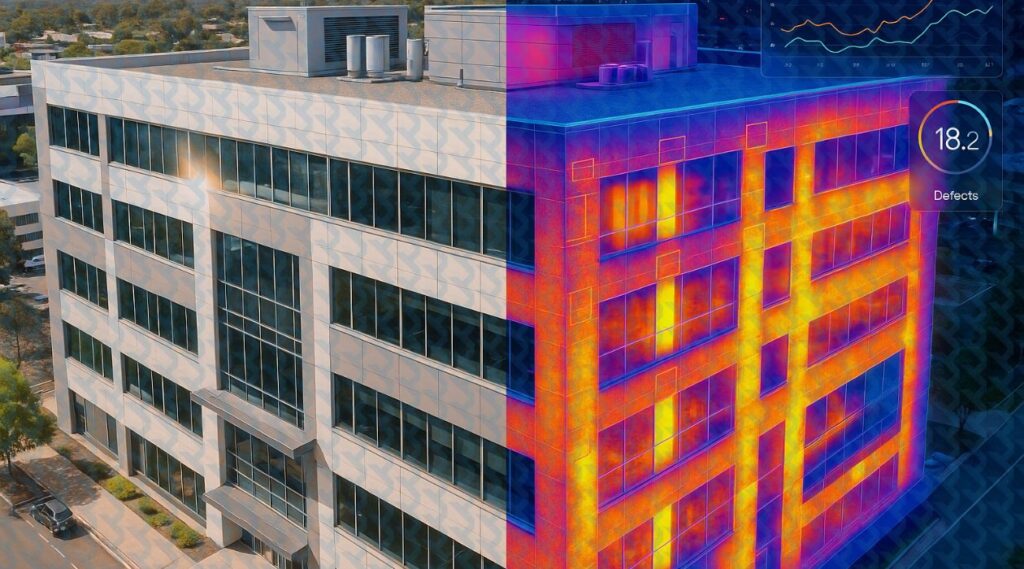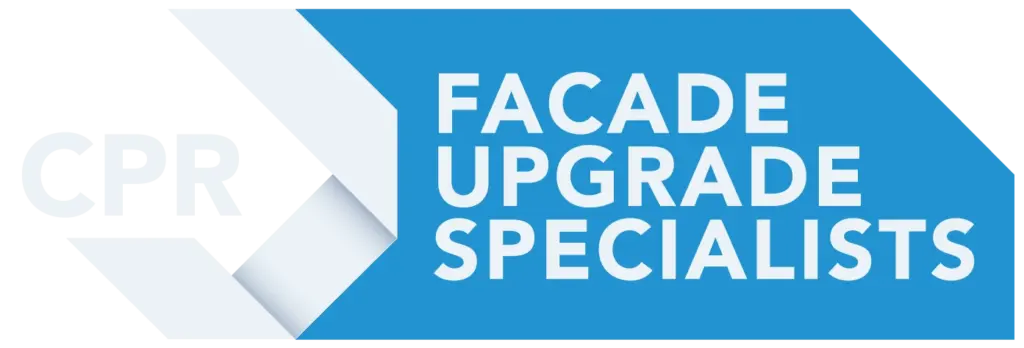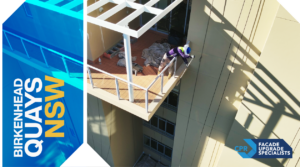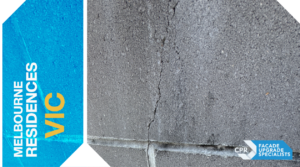When it comes to building envelope performance, guesswork costs money. That’s why more asset managers, strata committees, and government facility teams across Sydney are turning to CPR’s FIMS (Facade Intelligent Mapping System)—a digital twin solution that doesn’t just identify facade defects, but tells you when and where they’ll cost you.
In this article, we’ll explain how virtual twin technology is transforming building inspection and facility management through powerful facade defect mapping software, live building data, and savings that are anything but virtual.
What Is a Virtual Twin—and Why Your Building Needs One
Unlike a 3D model or BIM file, a virtual twin for buildings isn’t static. It’s a living, data-fed digital version of your building envelope—updating as sensors, scans, and inspections feed it.
With CPR’s FIMS system, this includes:
- LiDAR scans and drone photogrammetry for accurate elevation data
- Thermal imaging and moisture readings for real-world defect profiling
- Smart analytics that link envelope performance to energy usage, fire safety, and structural integrity
It’s more than visual—it’s functional. A true virtual twin lets facility managers not only see current issues, but simulate how conditions will change with time, weather or tenant use.
FIMS: The Future of Building Envelope Analysis

CPR’s FIMS suite integrates multiple technologies and methodologies to deliver comprehensive building envelope analysis, including:
1. High-Fidelity Data Capture
Using SkyPod® drones, Upseiling® access methods, and Scaffold-Free™ photogrammetry, CPR collects:
- Crack width and propagation patterns
- Cladding delamination zones
- Moisture ingress points
All captured with sub-centimetre accuracy and fed into the facade defect mapping software.
2. Intelligent Performance Modelling
Once the virtual twin is built, FIMS performs real-time building monitoring by comparing your building’s actual thermal performance, surface movement, and material behaviour to predictive models.
This enables:
- Predictive maintenance with digital twins
- Energy optimisation planning
- Long-term material stress forecasting
3. Actionable Insights, Not Just Data
Facility managers receive visual dashboards via SFS360® and asset-specific reports under SE2EPC® (Sky End 2 End Project Care®)—with clear calls to action. Whether it’s resealing a joint or planning facade replacement, you’ll know the what, where, and when.
Virtual Twins Deliver Real ROI
The power of digital twin building facade tools lies in measurable results. Here’s how they directly reduce cost and risk:
- Reduced reactive maintenance – Predict issues before they cause water damage or legal exposure.
- Lower energy use – Catch thermal bridging and air leakage hotspots fast.
- Informed capital planning – Prioritise works based on actual envelope degradation, not blanket assumptions.
- Fewer insurance headaches – With documented condition and real-time metrics, claims disputes drop.
Clients who’ve implemented FIMS building systems across their commercial or government sites consistently report 12–18% annual OPEX savings and far fewer compliance escalations.
Related Services Backed by FIMS
Digital Building Facade Inspections
CPR’s building facade inspection services are now entirely scaffold-free and fully integrated with virtual modelling.
- Defect mapping that’s traceable, timestamped, and geo‑locked
- Multi-trade scope reviews that plug directly into FIMS
- Ideal for condition audits, insurance, and DBP Act compliance
Book your digital inspection today →
Comprehensive Defect Scope & Reporting
Through SE2EPC®, CPR delivers technical reporting that speaks both to engineers and executive teams.
- 3D-mapped defects linked to budget-ready repair scope
- Live dashboards that update with each follow-up scan
- Readiness for certification, litigation or grant support
View sample scope & reporting workflow →
Remedial Consultancy, Now Data-Backed
Forget siloed consultants working off guesswork and site notes. With CPR, your facade consultancy services are powered by:
- Virtual twin data inputs
- Real-time issue tracking
- Coordination with remedial builders, engineers, and certifiers
Explore remedial consultancy services →
Real Projects, Real Insight: Sydney CBD Office
When a strata‑managed high-rise on Castlereagh Street faced water ingress and rising insurance costs, the committee turned to CPR for a FIMS-enabled evaluation. Within 72 hours:
- A digital twin was built
- All defects were classified and prioritised
- A multi-year remediation plan was set with clear CAPEX staging
12 months later, energy consumption was down 14%, insurance premiums stabilised, and facade compliance confirmed.
Why Facility Managers Love FIMS
“I’m not an engineer—but I get the full picture.”
Thanks to virtual twin energy savings and intuitive visuals, even non-technical managers can lead performance upgrades with confidence.
“Everything is traceable.”
With QR-coded facade sections, before/after timelines, and cloud-based logs, FIMS transforms risk from “unknown” to “managed”.
“We can justify spend to execs.”
From the boardroom to the boiler room, FIMS gives everyone the same view.
Key Benefits for Strata, Government & Commercial Asset Managers
- Gain clarity on building envelope performance
- Unlock savings through smart building optimisation
- Make decisions based on real evidence, not assumptions
FAQs: Digital Twin Building Facade Technology
Q: Is FIMS only for new builds?
No. FIMS is retrofit-ready and ideal for older stock—especially where records are sparse or envelope issues keep recurring.
Q: How often should we update the digital twin?
CPR recommends scanning every 6–12 months depending on building age, use and environmental exposure.
Q: Will it disrupt tenants?
Not at all. SkyPod® drones and Upseiling® inspections are minimally invasive, and we avoid scaffold installation entirely.
Q: What formats can I get the results in?
You’ll receive interactive dashboards, CSV export options, and PDF summaries formatted for exec reports or compliance submissions.
Q: What’s the cost compared to traditional inspection?
In most cases, FIMS cuts inspection costs 30–50% while vastly increasing data quality and usability.
Final Word: It’s Time to Stop Flying Blind
Your building envelope is too valuable to leave to spreadsheets, site notes, or vague assumptions. With FIMS and CPR’s digital twin for buildings, you can see, measure, and act with confidence.
Ready to uncover savings you can prove?
Book a digital inspection with CPR now →






